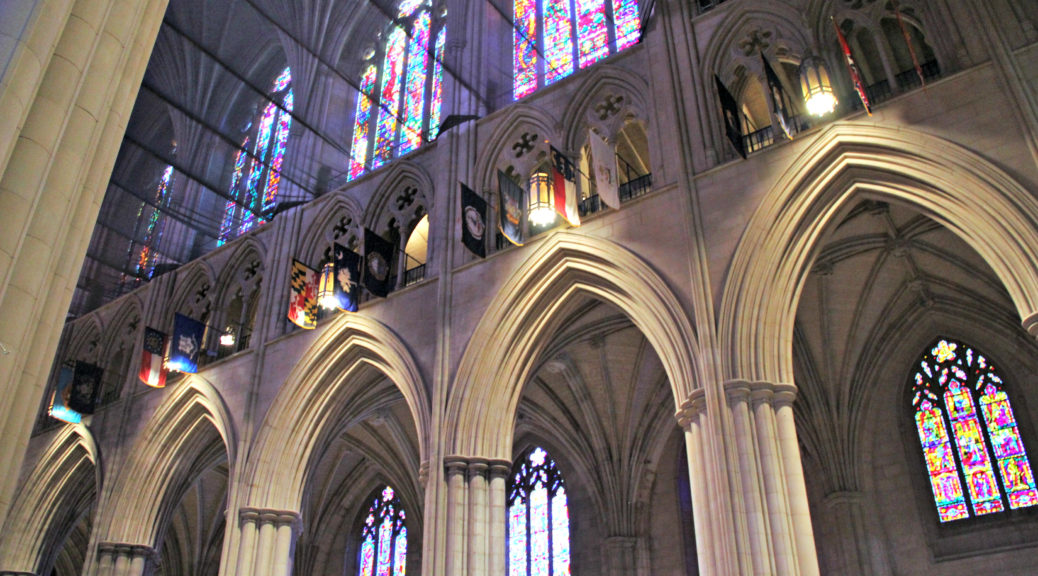
National Cathedral
The National Cathedral in Washington DC is an Episcopalian cathedral. While it is commonly known as the National Cathedral, its actual name is the Cathedral Church of Saint Peter and Saint Paul. The idea of a national church dates back to 1792 but it wasn’t until 1893 that Congress approved incorporation papers, authorizing a cathedral and institutions of higher learning in the District of Columbia. The charter was signed by President Benjamin Harrison. The Cathedral’s website indicates that the church does not receive any funds from the federal government.
The foundation stone for the Cathedral was laid in 1907 in the presence of President Theodore Roosevelt. The stone came from Bethlehem. While it wouldn’t be until 1990 that the Cathedral was officially completed, much happened in the interim. The Bethlehem Chapel held its first service in 1912. The Rev. Martin Luther King, Jr, delivered his last sermon from the Canterbury Pulpit in the cathedral proper in 1968 – he would be assassinated in the week that followed. President Eisenhower’s funeral service was held here in 1969 and prayer services were held following several presidents’ inaugurations.
The west towers of the Cathedral were completed in 1990, marking the official completion of the National Cathedral. President H.W. Bush was president at the time. Other parts of the Cathedral had been dedicated prior to this including the War Memorial Chapel (in 1957), the Gloria in Excelsis Tower (the central tower – in 1964), and the West Rose Window (in 1976). An earthquake damaged the Cathedral in August of 2011. The Cathedral was closed until November while structural repairs were made. The Cathedral did not have earthquake insurance so money needed to be raised for repairs which are still on-going.
The pictures below were taken at the front of the Cathedral or the west elevation. The towers are the ones that, when completed, marked the completion of the Cathedral. The second and third pictures are of the rose window symbolizing creation. The website describes the window like this:
The “Creation” Rose window contains more than 10,000 pieces of glass and celebrates when God declared, “Let there be light.” The “Creation” window starts in the middle, where pieces of white glass send thousands of rays of light radiating outward as the petals of a rose.
Credit: cathedral.org
The fourth picture in this section is of a sculpture above the main entrance of the Cathedral. It is titled “Ex Nihilo” which is a Latin phrase meaning “out of nothing.” The sculpture represents the birth of mankind. It shows the partially formed bodies of men and women. The figure of Adam is just below this sculpture. The sculptures over the doors to the left and right of the central door are the “Creation of Day” and the “Creation of Night.”
The last picture is of the Cathedral from the side – I took this picture as we were leaving. If you look closely, you will see the flying buttresses which help support the walls of the Cathedral.
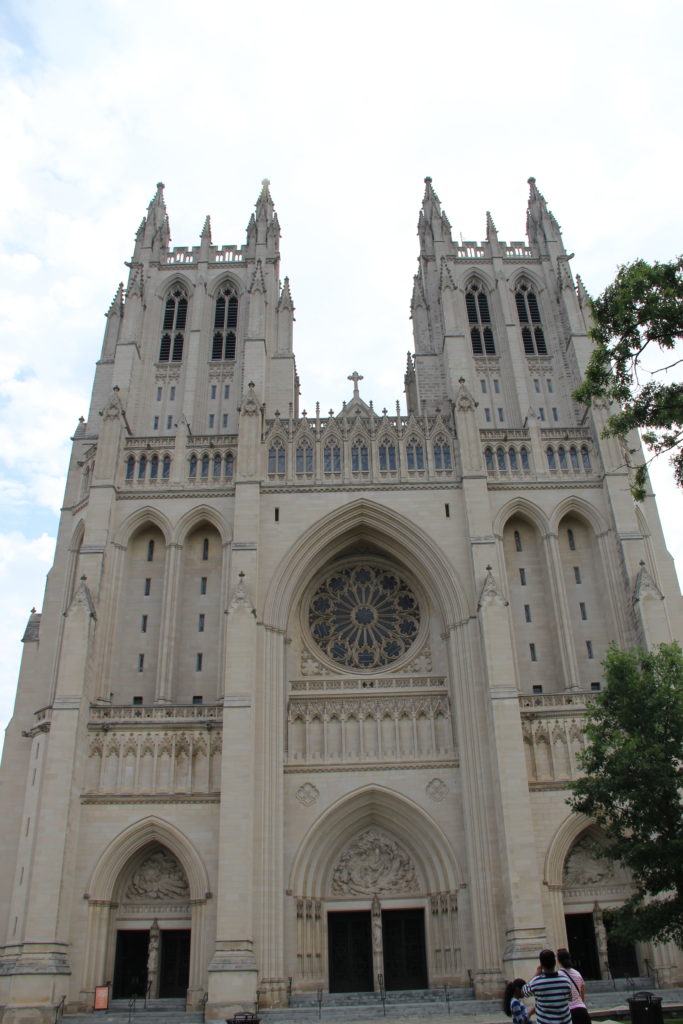



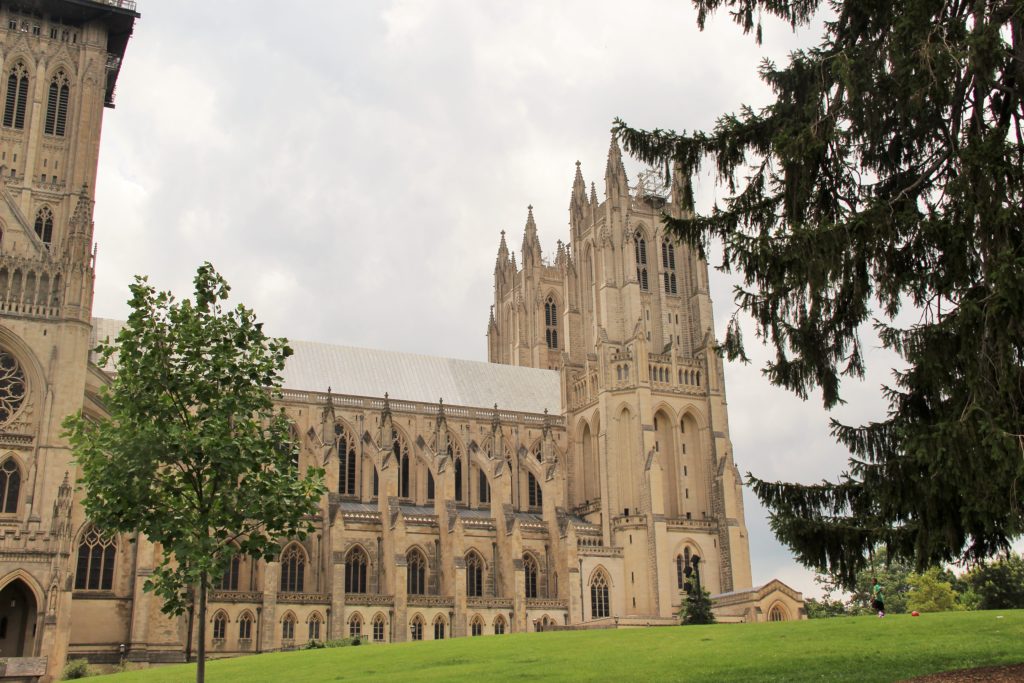
These are pictures of the interior of the Cathedral. The first one was taken near the front of the church looking toward the back. Near the top you can see some of the protective sheeting being used for the ongoing repairs required because of the 2011 earthquake. The flags represent the 50 states.
The next two pictures highlight some of the beautiful columns, archways and stained glass windows in the nave of the Cathedral. Much of the interior of the church is made of limestone. There are 231 stained glass windows in the Cathedral that were completed over an 80 year period. Most of the windows have a religious theme, such as the apostles, angels, and the life of Jesus, including His miracles and parables. Others are secular representing the beauty of the United States, science and technology, women in American history and American statesmen.
The last two pictures in this section are of the vaulted ceiling, which is just over 300 feet high. Light is steaming into the Cathedral through the stained glass windows giving some of the pillars and parts of the ceiling a red glow. Within the Cathedral, there are over 700 boss stones (arrow depicts one of these in the last picture). These are the carved part of a stone that helps to hold the ribs of the vaulted ceiling in place. In the National Cathedral, many of the boss stones depict portions of the Nicene Creed – so they not only provide structural support for the ceiling but also symbolize the foundation of the Christian faith.
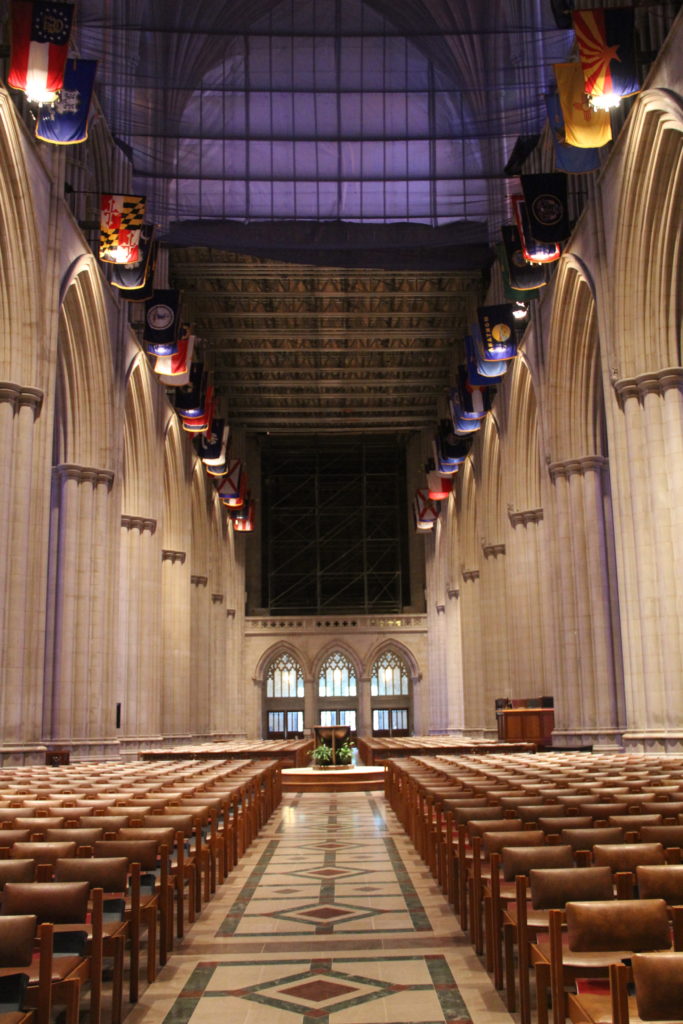

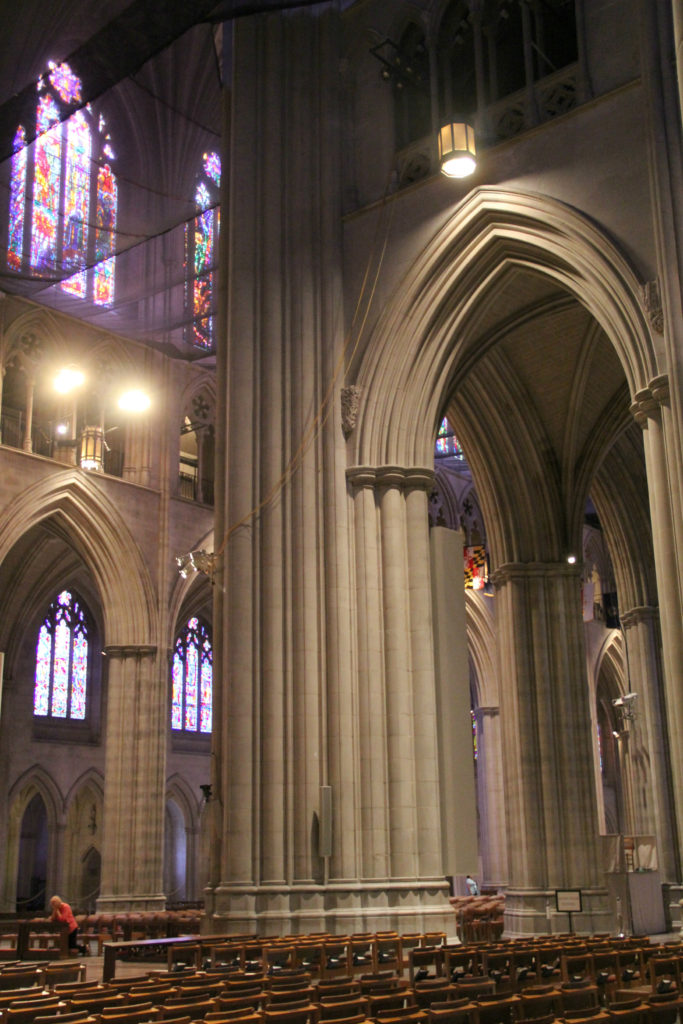
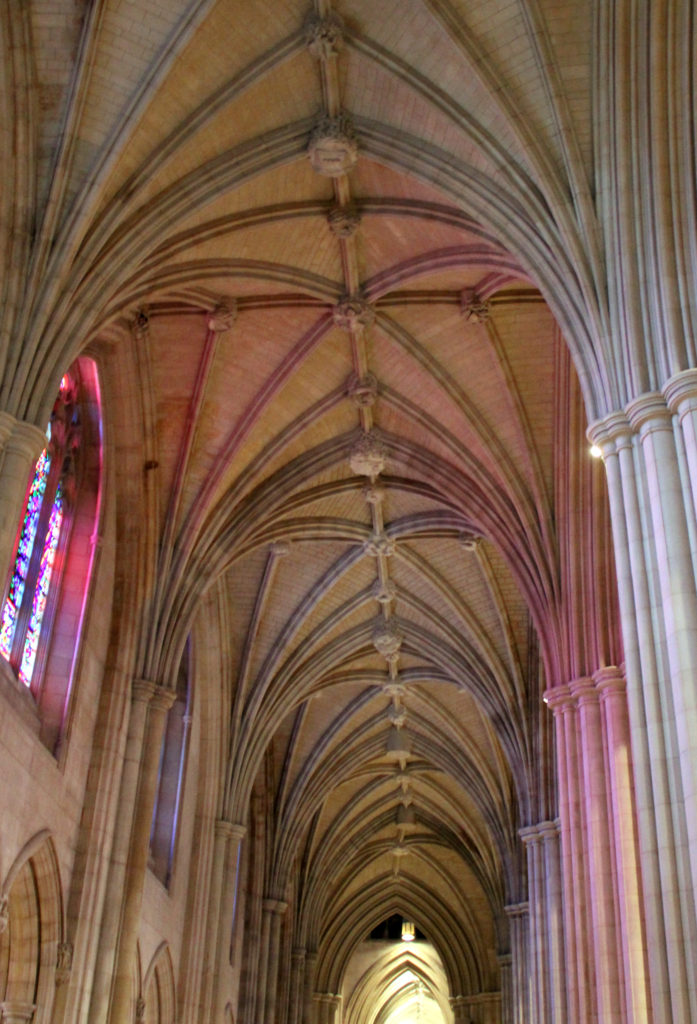

These are close-up pictures of two stained glass windows. The first is another rose window and is entitled “Church Triumphant.” The window has a diameter of 24 feet. God the Father sits in the middle of the window with one hand raised in blessing and the other holding a lamb, representing Jesus. The window is based on writings in Revelation. Its biblical meaning together with others in the South Transept are described in the quote below.
Emphasizing unity among Christians in their core beliefs, the windows bear witness to the diversity of Christian expression throughout history and around the world, and look forward to the coming Great Church, the Church Triumphant, foretold in the Book of Revelation.
Jewels of Light: The Stained Glass of Washington National Cathedral (Elody R. Crimi and Diane Ney)
The next two pictures are of the “Scientists and Technicians Window,” more commonly known as the “Space Window.” The Apollo 11 crew presented the National Cathedral with a piece of basalt moon rock which was incorporated into the window. It came from the Sea of Tranquility. Photographs taken during the mission inspired the design of the window. It is meant to suggest the vastness of the universe. It is the only window in the Cathedral where all three parts of the window comprise a single scene. Interestingly, it is not the only window to incorporate a rock or stone. A window entitled the Suffering and Redemption includes a rock taken from a wall in Jerusalem.


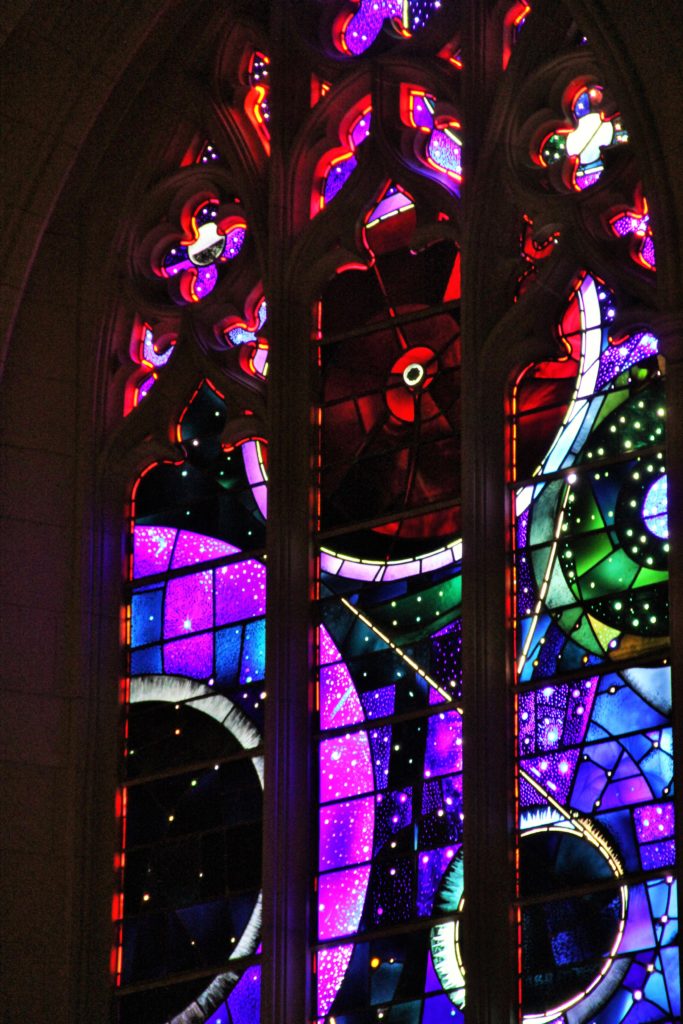
The next pictures are of the high altar and the reredos behind the altar. A reredos is an altarpiece which is usually decorated with religious images. This one is entitled Ter Sanctus and features the figure of Christ in the middle. He is holding up one hand in blessing and holds an orb in the other, representing ultimate authority. It took two years to complete this sculpture. Surrounding Christ are 110 other sculptures depicting angels and saints. The six larger figures on either side of Christ are not identified and represent the works of mercy from the book of Matthew (For I was hungry and you gave me food…). The third picture is a close-up of a part of the reredos showing the institution of the Lord’s Supper. This picture shows the tremendous detail in these very intricate sculptures.
The last picture focuses on the altar. It is made of limestone that came from a quarry in Jerusalem. It is believed that rocks from this same quarry were used to build the Temple of Solomon. To give you perspective, the cross on the altar is nearly six feet tall. This massive size is needed so the high altar can be seen from the back of the Cathedral which is about 530 feet back.

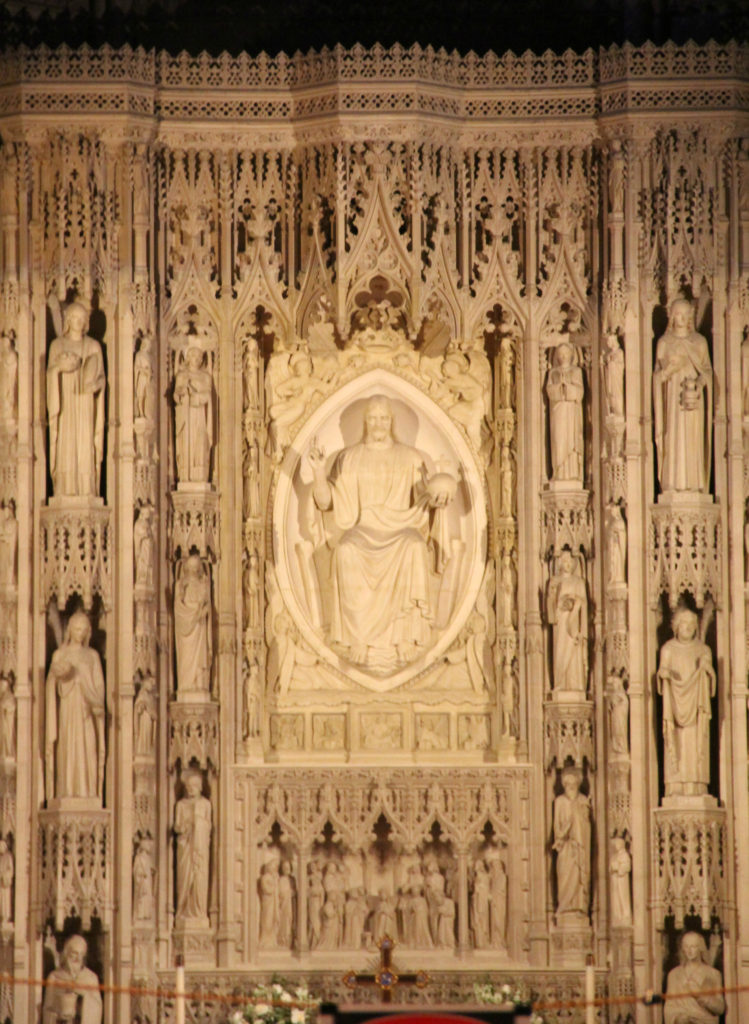

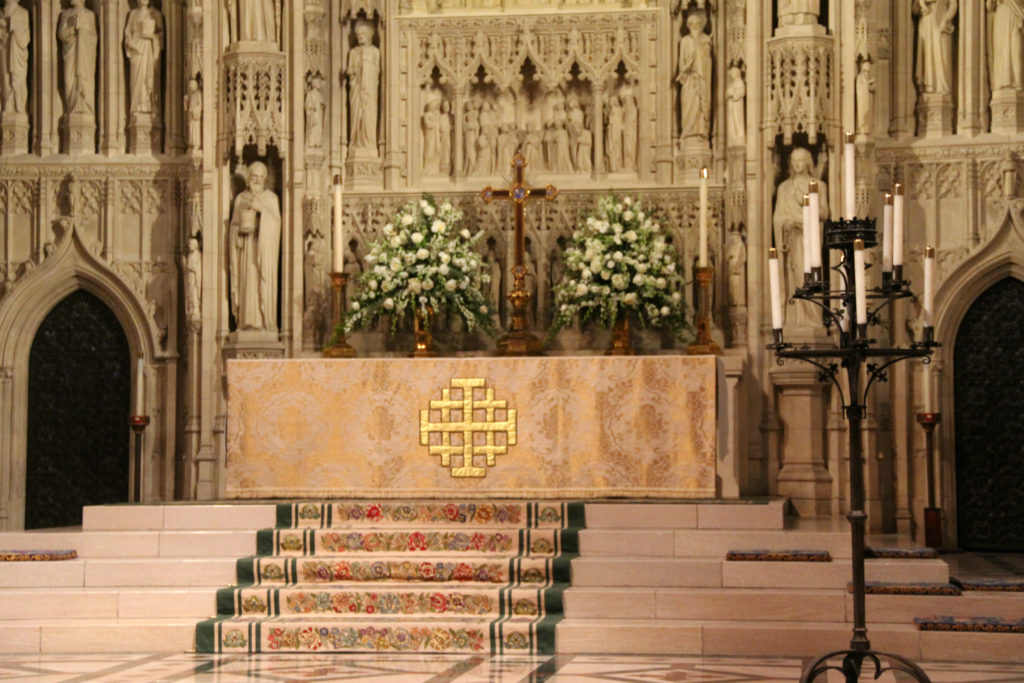
This section of pictures depicts the rood screen and the pulpit. In medieval times, the church served multiple functions and the screen separated the sacred part of the church from the secular part. Today it serves to mark the holiest part of the church, the altar and choir area. The first picture below was taken from the congregational side of the rood screen and the next two from the area where the choir sits (looking out toward the back of the church). There is also a chair called the Glastonbury Cathedra or the Bishops’s Chair (fourth picture) in the choir area. Stones from the Glastonbury Abbey in England were used to make the chair. The writing on the back of the chair is Latin and is translated, “Holy Scripture and Apostolic Creed, Holy Sacrament and Apostolic Order.”
The Canterbury Pulpit is pictured next. It is made of stone from the Bell Harry Tower of the Canterbury Cathedral in England. The pulpit was carved in England and features scenes depicting the history of the Bible’s translation into English.
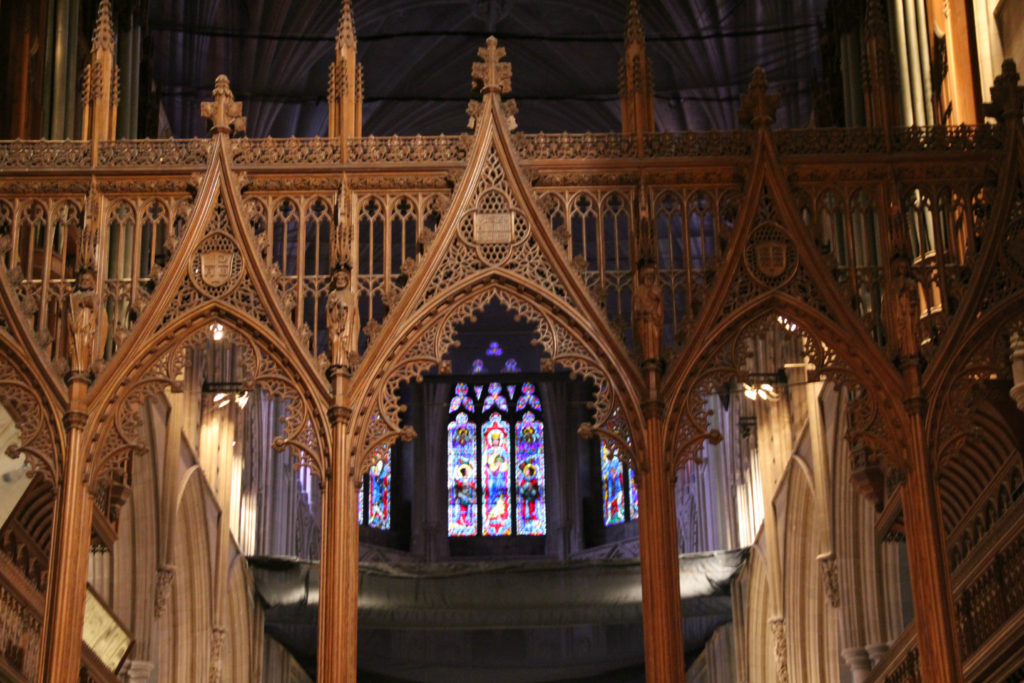
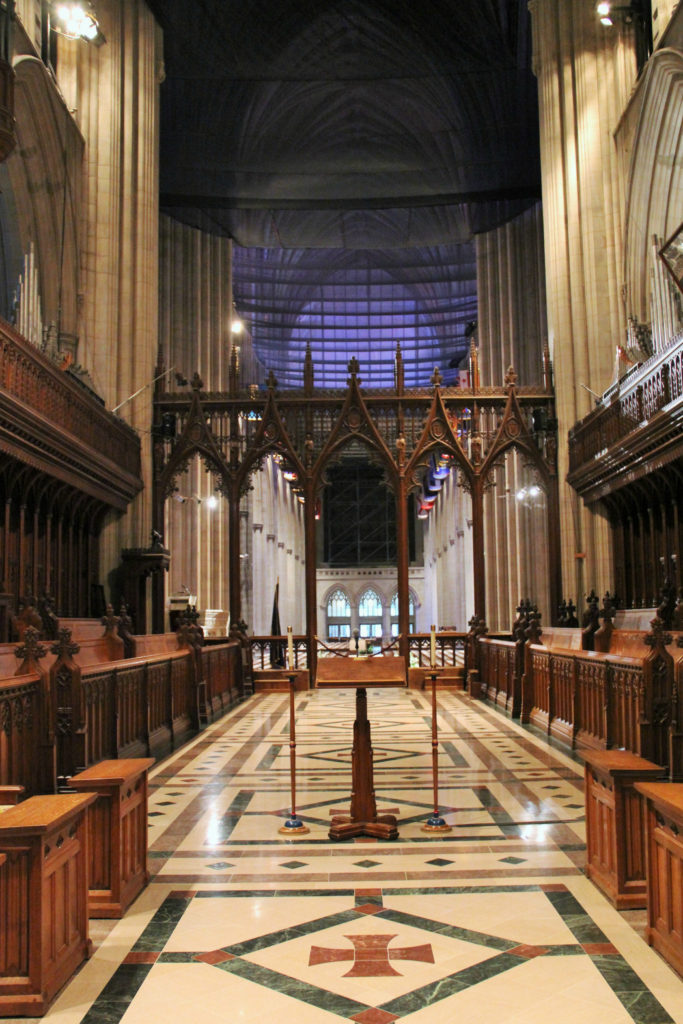
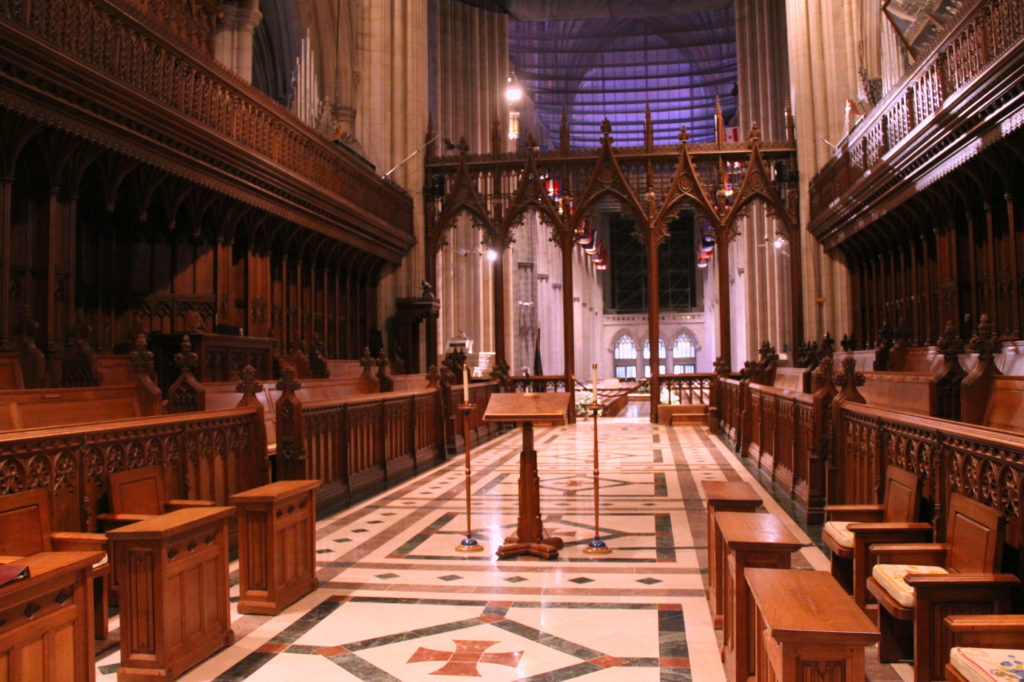
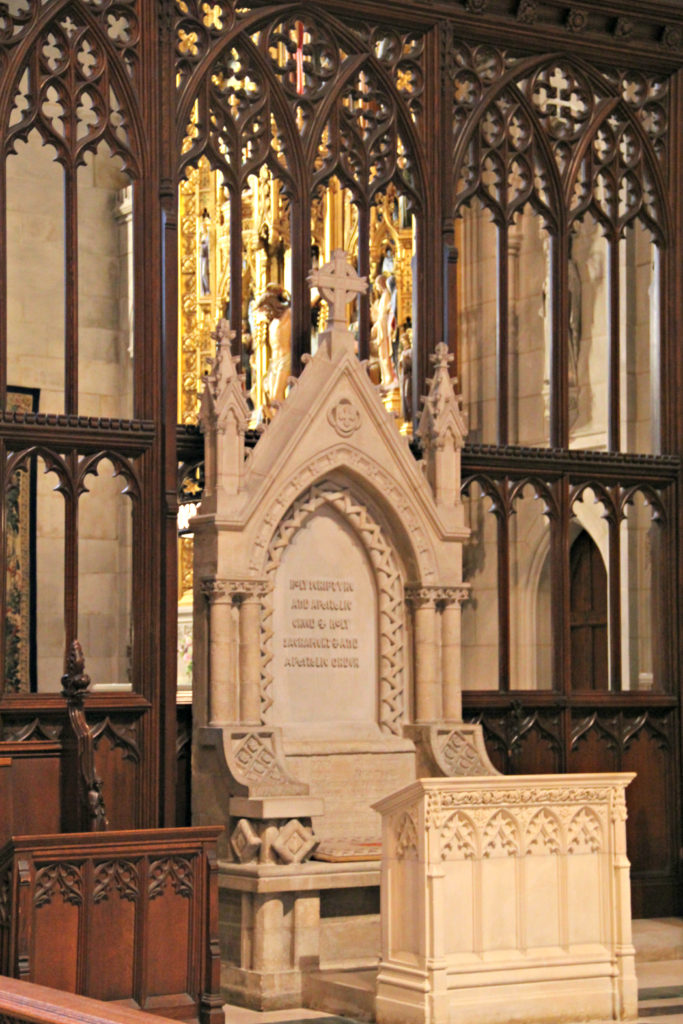
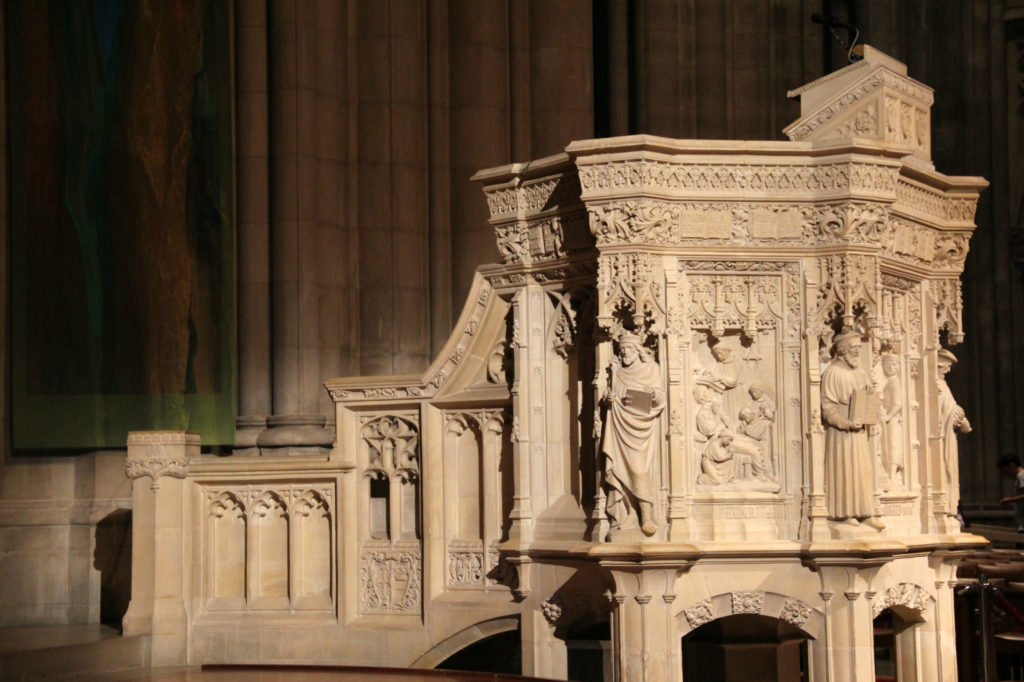
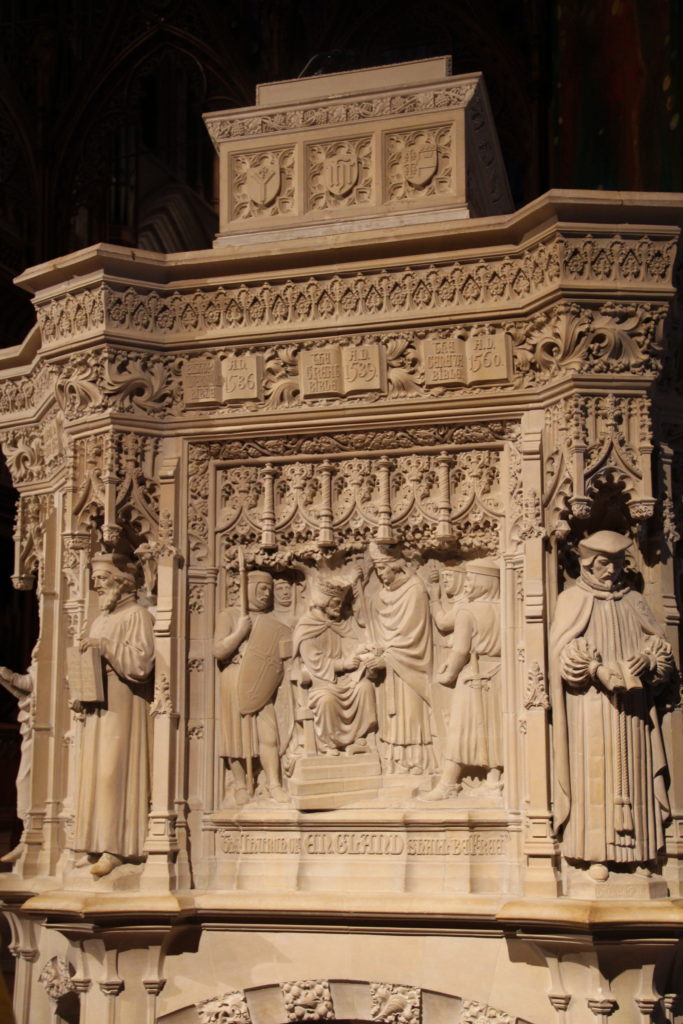
The pictures below are of two of the nine chapels within the National Cathedral. The first is St. Mary’s Chapel. The reredos is carved from linden wood and then gilded. It pictures events from Mary’s life including an angel foretelling Jesus’ birth, the wedding at Cana and Jesus’ crucifixion.
The next pictures are of the Children’s Chapel. It is designed for children who are about six years old and was donated by a couple who lost a child at age six. The Chapel has small chairs and even a small organ. The last picture is part of the reredos and shows a young Jesus impressing church elders with His Biblical knowledge. This is one of two cathedrals in the world with a chapel designed specifically for children. Baptisms frequently occur here.

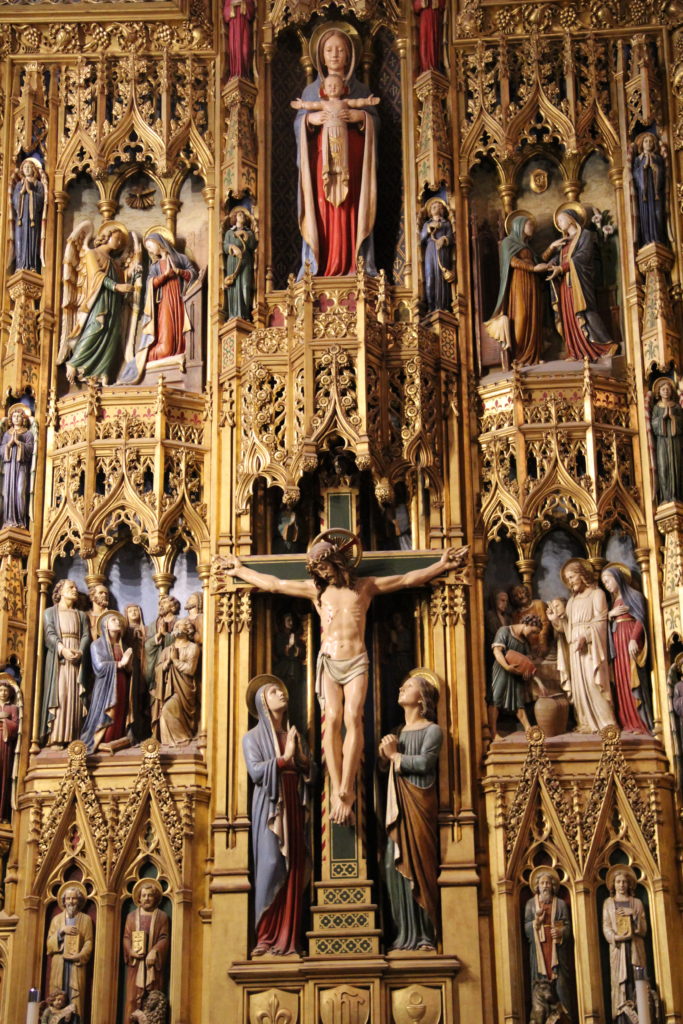


Another chapel within the National Cathedral is the War Memorial Chapel. The first picture below shows the figure of Christ in this Chapel. He is described as reflecting on the world. His halo is made of brass and aluminum – the brass shapes intended to look like canon shells and the aluminum symbolizing glory. At the back of the Chapel is the Pentagon Cross which you will see in the second picture. It is made of some of the debris left from the 9/11/2001 attack on the Pentagon. It was presented to the Cathedral by the Chief of Chaplains of the US Army.
The third picture is one of 175 kneeler cushions in the St. John’s Chapel. They are needlepointed with designs that reflect contributions of people who influenced American politics and culture. Among these are all the deceased presidents as well as artists, authors, musicians, scientists, statesmen and others. The kneeler pictured is in honor of Robert Goddard, the “father” of modern rocketry. Needlepoint can be found in many other parts of the Cathedral as well – in fact, there are more than 1,500 pieces of needlepoint within the Cathedral.
Finally, there is a picture I took while in the back of the Cathedral looking toward the altar. While I tend to take a lot of pictures showing details of what I am seeing, it is also nice to step back and get a sense of the whole – that was the intent of this picture.
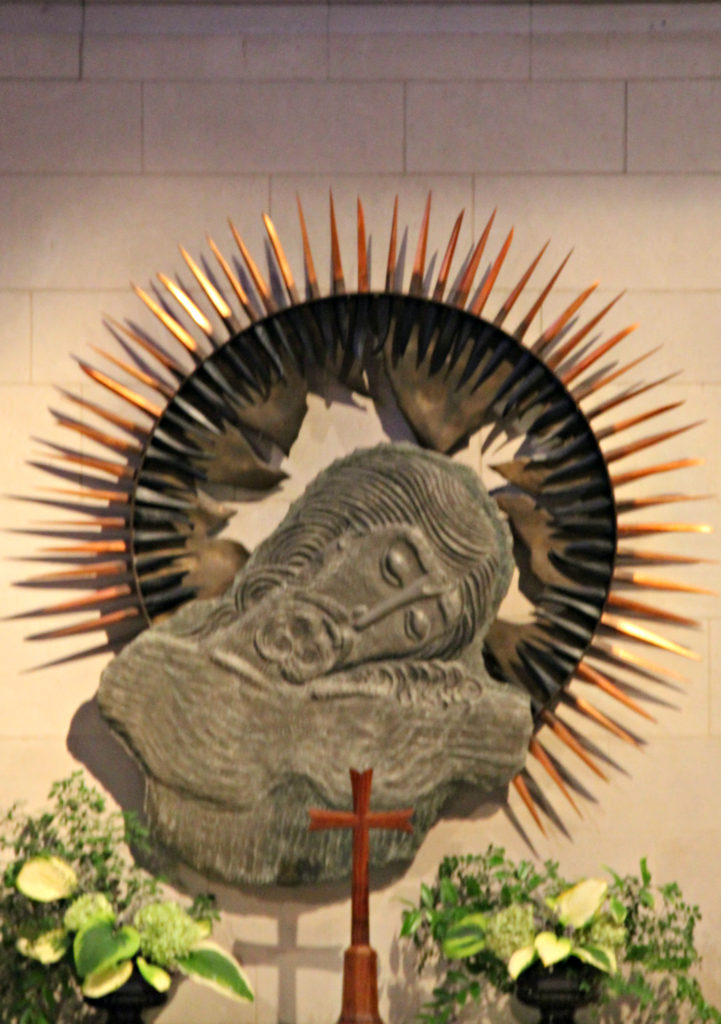


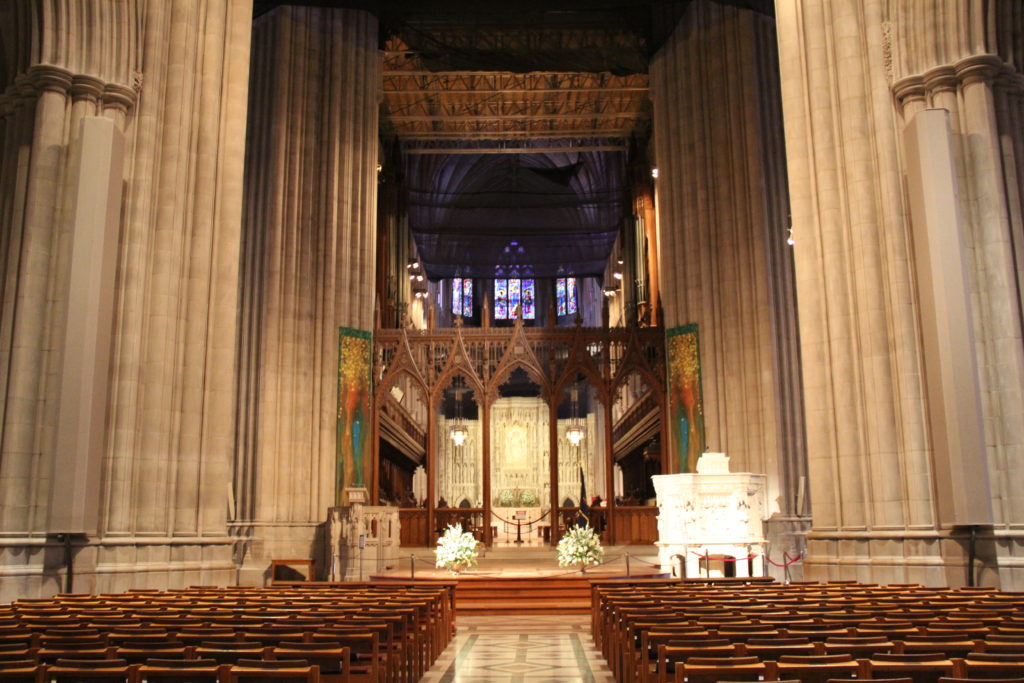

While doing more reading about the National Cathedral, I realized how much I missed during our visit. We did walk through the Cathedral with a docent, but there are also tours you might want to consider. At cathedral.org you will find a link, “Experience the Cathedral.” There you will find another link to upcoming tours. There are several different kinds including a “behind the scenes” tour, a gargoyle tour, a bell tower climb and others. If you are considering a tour, I would suggest booking it in advance. You might also want to bring binoculars so you can see some of the detail (such as the carvings on the boss stones). We focused on the interior of the Cathedral but there is much to see on the outside as well. I hope to visit the Cathedral again and will definitely take advantage of one of the tours!